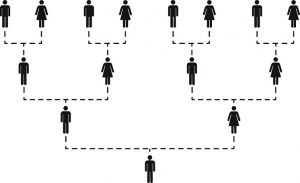As you work your way down the rows and columns of your family tree, you’ll sometimes encounter terms like “once removed” or “thrice removed.” These suffixes indicate how many generations separate you from a common ancestor. For example, if your dad’s brother has children, those kids are your first cousins once removed.
They’re Your Grandparents’ Grandchildren
In general, relatives who share one of your parent’s siblings are first cousins. If those cousins have children, you’re their 1st cousin once removed. Their grandchildren are your FCORs’ children. Generations before you are harder to determine, and how they’re labeled depends on how far back in your common ancestor’s family tree the relationship goes. For example, if you have a first cousin once removed whose grandparents are your great-grandparents, and you are one generation younger than that person’s grandparents, you’re first cousins twice removed.
The relationship becomes more complicated as you add generations to the end of the chain, and the terms cousin-uncle/aunt (referring to the older generation) and cousin-niece/nephew (referring to the younger generation) distinguish cousins from their uncles or aunts. Likewise, cousin-great-uncle/niece and cousin-great-uncle/niece are also used.
As the relationship gets more distant, fewer and fewer centimorgans of DNA are shared. In fact, by the time you get to fifth cousins, it’s unlikely that commercial ancestry tests can even detect the connection. Understanding the difference between first cousins and first cousins once removed is essential when researching genealogy. The more you can understand the relative relationships between your matches, the more accurate your results will be. Then you’ll be able to pinpoint the specific ancestor(s) you have in common with your partner.
They’re Your Grandparents’ Great-Grandchildren
Genealogists are often faced with a list of cousins that have varying degrees of closeness to each other. A clear understanding of what these relationships mean can help you understand your family tree and can be a big help when matching with other relatives through DNA testing.
For example, if you discover that the brother of your first cousin is your second cousin once removed, it means that he and you share a common great-grandmother but are separated by one generation. If he has children, those kids are your second cousins once removed because they share the same great-grandmother but are a generation away from you.
Similarly, the daughter of your third cousin is your third cousin once removed because she shares the same great-grandparents but is a generation away from you. And if she has a child, that child becomes your third cousin once removed because he shares the same great-grandparents but is a different generation from you.
Essentially, you can determine the degree of removal by counting how many “greats” are in your common ancestor’s title and adding one. For instance, your cousin’s son is your first cousin once removed because you share the same great-grandparents, but he is a generation away from you.
They’re Your Great-Grandparents’ Great-Grandchildren
Many genealogists will encounter cousins with varying degrees of closeness, and knowing how to define these relationships is essential for understanding the family tree and verifying DNA matches. The terms “once removed,” “twice removed,” and so on can be confusing. We’re here to shed some light on what they mean.
When someone is described as “once removed,” it simply means that there are one or more generations between you and your common ancestor. You can count the ages between you and your cousin to determine their relationship; for example, if your first cousin is in the same generation as you, they are your first cousin. If they have children, then the child of your first cousin is your second cousin, and so on.
You can use a cousin chart to help you with more complicated relations. Remember that “once removed” indicates one generation between you and your cousin, so be sure to add a generation when comparing different types of relations on the chart. For example, if your first cousin is once removed and has two daughters, one would be your second cousin, and the other would be your third cousin. Then, if the second daughter had a son, that son would be your fourth cousin, and so on.
They’re Your Great-Grandparents’ Great-Grandchildren
Whether counting cousin relationships or matching ancestry DNA, degrees of cousinhood is significant in genealogy research. Understanding how to calculate these relations is critical. For instance, “once removed” or “twice removed” refer to the number of generations separating you from a common ancestor. To understand this concept, start by looking at the relationship of your first cousin. A first cousin is someone you share the same grandparents with. The child of your first cousin, however, is a first cousin once removed. The reason is that you share the same great-grandparents, but they are one generation younger than you.
Once removed, the relationship between you and a first cousin gets progressively more complicated as you move back. To calculate the relationship between you and a first cousin once or twice removed, subtract the number of generations from the connection between your straight-numbered cousins. For example, if Ann’s uncle is her first cousin once removed, Ann and Bea are first cousins. Then, add one generation for each additional removal to determine the cousin relationship between you and a straight-numbered first or second cousin once or twice removed.
To confuse matters, there are inverse titles for cousins, such as cousin-uncle and cousin-niece or cousin-nephew. While these titles don’t affect the degree of cousinhood between you and your cousin, they are helpful to know when determining how closely you are related to a specific person.







